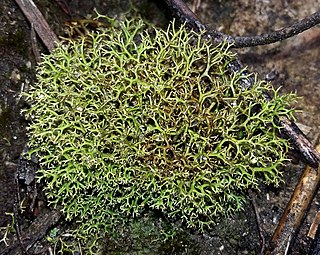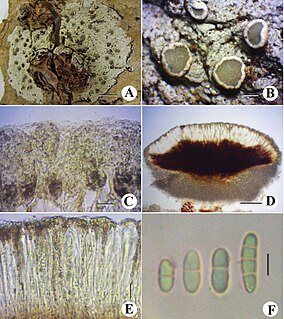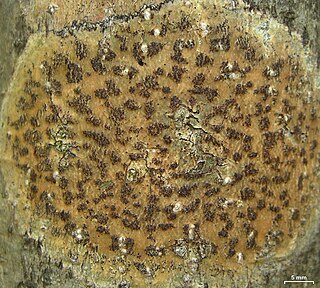Biatorellaceae is a family of lichen-forming fungi in the subclass Lecanoromycetidae. The family is monotypic, and contains the single genus Biatorella, which contains eight species. Species in the genus are found in northern temperate regions, especially in Europe.
Coppinsia is a genus of lichenized fungi in the family Trapeliaceae. This is a monotypic genus, containing the single species Coppinsia minutissima.

Cladia is a genus of lichenized fungi in the family Cladoniaceae. Cladia species have a crustose primary thallus and a fruticose, secondary thallus, often referred to as pseudopodetium. The type species of the genus, Cladia aggregata, is widely distributed, occurring from South America, South Africa, Australasia and South-East Asia to southern Japan and India. Most of the other species are found in the Southern Hemisphere.
Badimia is a genus of foliicolous (leaf-inhabiting) lichens in the family Ramalinaceae.
Microcaliciaceae is a family of lichen-forming fungi in the order Pertusariales. It contains the single genus Microcalicium, circumscribed by Finnish lichenologist Edvard August Vainio in 1927, with Microcalicium disseminatum assigned as the type species.

The Ophioparmaceae are a small family of lichen-forming fungi in the order Umbilicariales. The family was circumscribed in 1988 by lichenologists Roderick Westgarth Rogers and H. Thorsten Lumbsch.

Architrypethelium is a genus of lichen-forming fungi in the family Trypetheliaceae. The genus was circumscribed in 1991 by Dutch lichenologist André Aptroot, with A. seminudum assigned as the type species. It is a segregate of genus Trypethelium.

The Arctomiaceae are a family of lichenized fungi in the Ascomycota, class Baeomycetales. The family was named by Theodor Magnus Fries in 1861, with Arctomia as the type genus. Species in this family are found in arctic and subarctic habitats, usually associated with bryophytes.
Gregorella is a genus of lichenized fungi in the family Arctomiaceae. This is a monotypic genus, containing the single species Gregorella humida.

The Tephromelataceae are a family of lichenized fungi in the order Lecanorales. The family was circumscribed by Austrian lichenologist Josef Hafellner in 1984. Tephromelataceae comprises the genera Tephromela, Calvitimela, Mycoblastus and Violella, which together constitute a well-supported monophyletic group.

Kalbionora is a lichen genus in the family Malmideaceae containing the single crustose species Kalbionora palaeotropica. This lichen occurs in coastal forests in Thailand, Vietnam, and northeastern Australia, where it grows on tree bark.

Trapeliaceae is a family of lichens in the order Baeomycetales. The family contains 12 genera and about 125 species.

Pulchrocladia is a genus of fruticose lichens in the family Cladoniaceae. It has three species. The genus was circumscribed in 2018 by lichenologists Soili Stenroos, Raquel Pino-Bodas, Helge Thorsten Lumbsch, and Teuvo Ahti. The genus name refers to "the beautiful morphology of its species".

Schaereria is a genus of lichen-forming fungi. It is the sole genus in the family Schaereriaceae, which itself is the only family in the Schaereriales, an order in the subclass Ostropomycetidae of the class Lecanoromycetes.

Loxospora is a genus of lichen-forming fungi in the family Sarrameanaceae. It has 13 species. The genus was circumscribed by Italian lichenologist Abramo Bartolommeo Massalongo in 1852, with Loxospora elatina assigned as the type species. This crustose lichen was originally named Lecanora elatina by Erik Acharius in 1810.
Lambiella is a genus of lichen-forming fungi in the family Xylographaceae. The genus was circumscribed by German botanist Hannes Hertel in 1984, with Lambiella psephota assigned as the type species.

Viridothelium is a genus of lichen-forming fungi in the family Trypetheliaceae. It has 11 species. The genus was circumscribed by Robert Lücking, Matthew Nelsen, and André Aptroot in 2016, with Viridothelium virens assigned as the type species. Lichens in this genus were previously assigned to genus Trypethelium, as part of the Trypethelium virens clade.

Megalospora is a genus of lichen-forming fungi in the family Megalosporaceae.
Halegrapha is a genus of lichen-forming fungi in the family Graphidaceae. It has nine species. The genus was circumscribed in 2011 by Eimy Rivas Plata and Robert Lücking, with Halegrapha chimaera assigned as the type species. The generic name honors American lichenologist Mason Hale.
Elixia is a genus of crustose lichens in the family Elixiaceae. It has two species:











